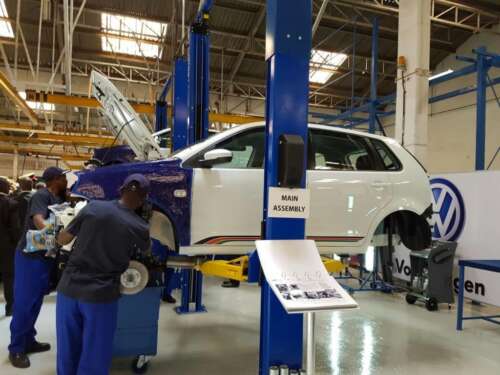The African automotive market has been predicted to grow at a CAGR of around 6.5 per cent from 2018 until 2026.
Of all automobile markets in the world, Africa’s is the most underdeveloped except for South Africa, Morocco, Egypt and Algeria. The automotive market in the rest of Africa is considerably small in comparison.
The low-average income and the lack of a sizeable middle-class population are the major reasons for this limited growth. In addition, the high lending rates have made ownership of a car restricted only to the wealthy and prosperous.
Read: German Volkswagen eyes Ethiopian market with assembling plant
Ghana, which is a promising market, has a car loan interest rate that fluctuates around 32 per cent. Nigeria, which is the biggest economy on the continent has a loan interest rate of about 12 per cent. With these numbers, it makes taking a car loan an expensive proposition which hinders the automobile market in the country.
Another big challenge to the automotive industry on the continent is the importation of used cars from other countries.
Countries like Kenya, for instance, get cars from Japan where strict vehicle inspections force cars out of circulation after just a few years. For the sector to outgrow these challenges in the East African nation, the government plans winding down imports of cars that are more than three years old by the end of this year.
According to Mordor Intelligence, the African market has high growth prospects in the automobile sector.
For a continent with 1 billion inhabitants, it only occupies 1 per cent of the global new car sales. For perspective, South Africa controls 85 per cent of the total new cars sold in the sub-Saharan region where there is a potential for up to 3-4 million cars from the existing number of around 425,000.
Investors who are willing to seriously enter the region could benefit from the formation of the Association of African Automotive Manufacturers (AAAM) where they are expected to benefit from reforms and policies.
Some of the benefits for any car company that sets up a local assembly plant in Nigeria, Kenya and Ghana, could get tax holidays of up to 10 years and duty exemptions.
Another reason why the African market is a good prospect is that infrastructure is increasing on the continent which is likely to aid the automotive market of the region.
For Morocco, its integration into the global economy was facilitated by the signing of numerous free trade agreements with the European Union and the United States. These trade agreements have contributed positively towards the emergence of export activities in the country.
At home, the automobile market opportunities have not gone unnoticed with the African Export-Import Bank (Afreximbank) and AAAM partnering for the financing and promotion of the automotive industry in Africa.
Afreximbank President Prof Benedict Oramah, and Mike Whitfield, President of AAAM and Managing Director of Nissan Africa, signed a Memorandum of Understanding (MoU) in early February, formalizing the basis for a partnership aimed at boosting regional automotive value chains and financing for the automotive industry while supporting the development of enabling policies, technical assistance, and capacity building initiatives.
Read: EAC keen on thriving low-cost car assembly, manufacturing plants into the region
Oramah said that the strategic partnership with AAAM will facilitate the implementation of the Bank’s Automotive programme which aims to catalyse the development of the automotive industry in Africa as the continent commences trade under the African Continental Free Trade Area (AfCFTA).
Under the terms of the MoU, Afreximbank and AAAM will work together to foster the emergence of regional value chains with a focus on value-added manufacturing created through partnerships between global Original Equipment Manufacturers (OEM), suppliers, and local partners. The two organizations plan to undertake comprehensive studies to map potential regional automotive value chains on the continent in regional economic clusters, in order to enable the manufacture of automotive components for supply to hub assemblers.
To support the emergence of the African automotive industry, they will collaborate to provide financing to industry players along the whole automotive value chain. The potential interventions include lines of credit, direct financing, project financing, supply chain financing, guarantees, and equity financing, amongst others.
The MoU also provides for them to support, in conjunction with the African Union Commission and the AfCFTA Secretariat, the development of coherent national, regional and continental automotive policies, and strategies.
With an integrated market under the AfCFTA, abundant and cheap labour, natural resource wealth, and a growing middle class, African countries are increasingly turning their attention to support the emergence of their automotive industries.
Therefore, the collaboration between Afreximbank and AAAM will be an opportunity to empower the aspirations of African countries towards re-focusing their economies on industrialization and export manufacturing and fostering the emergence of regional value chains.
AAAM CEO David Coffey said the signing of the MoU with Afreximbank was a major milestone for the development of the automotive industry in Africa.
At the 2020 digital Africa Auto Forum, the lack of affordable financing available for the automotive sector was identified as one of the key inhibitors for the growth and development of the automotive industry in Africa.
Other areas covered by the MoU include working with the African Union and the African Organization for Standardization to harmonize automotive standards across the continent and developing an automotive focused training program for both the public and private sector.
The sector has seen some activity recently with multinational vehicle manufacturers currently setting up production plants in Kenya, Ethiopia, Rwanda, Angola, Ghana, Namibia, Nigeria, South Africa and other countries. This is a clear indicator that there is potential to boost manufacturing for the sector in the Sub Saharan Africa region.
With demand for vehicles slowing down in developed countries and growing in emerging economies, including SSA, there is an opportunity for the sector to grow to meet domestic demand.
